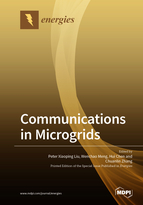Communications in Microgrids
A special issue of Energies (ISSN 1996-1073).
Deadline for manuscript submissions: closed (31 October 2018) | Viewed by 18280
Special Issue Editors
Interests: control theory and systems; teleoperation; telehaptics; haptic control; soft tissue modeling; cutting simulation
Special Issues, Collections and Topics in MDPI journals
Interests: adaptive intelligent control; cyber physical system; renewable energy system; smart grids
Interests: microgrid modelling and control; smart grids
Interests: systems and control; nonlinear systems; intelligent systems; smart grids
Special Issue Information
Dear Colleagues,
Future microgrids are expected to be small-scale power systems that can offer increased reliability and facilitate effective integration of distributed generators and energy storage devices. These new capabilities are made possible by integrating advanced communication technologies that can support efficient, secured and reliable end-to-end two-way information flows. Such advanced communication technologies are key enablers for various future microgrid applications, such as demand response, advanced metering infrastructure (AMI), energy storage integration, electric vehicle (EV) charging and seamless integration of renewable energy sources. A number of different schemes for microgrid communications have recently emerged such as home area networks (HANs), field area networks (FANs) and wide area networks (WANs). The tight coupling between communication technologies and microgrids also introduces security risks that must be mitigated from a cyber–physical perspective. Moreover, the increasing sensing abilities of microgrids may also raise privacy concerns that must be addressed. The main objectives of this Special Issue dedicated to communications in microgrids are to highlight the latest advances in communications for microgrids.
Prof. Dr. Peter X. LiuDr. Wenchao Meng
Dr. Hui Chen
Dr. Chuanling Zhang
Guest Editors
Manuscript Submission Information
Manuscripts should be submitted online at www.mdpi.com by registering and logging in to this website. Once you are registered, click here to go to the submission form. Manuscripts can be submitted until the deadline. All submissions that pass pre-check are peer-reviewed. Accepted papers will be published continuously in the journal (as soon as accepted) and will be listed together on the special issue website. Research articles, review articles as well as short communications are invited. For planned papers, a title and short abstract (about 100 words) can be sent to the Editorial Office for announcement on this website.
Submitted manuscripts should not have been published previously, nor be under consideration for publication elsewhere (except conference proceedings papers). All manuscripts are thoroughly refereed through a single-blind peer-review process. A guide for authors and other relevant information for submission of manuscripts is available on the Instructions for Authors page. Energies is an international peer-reviewed open access semimonthly journal published by MDPI.
Please visit the Instructions for Authors page before submitting a manuscript. The Article Processing Charge (APC) for publication in this open access journal is 2600 CHF (Swiss Francs). Submitted papers should be well formatted and use good English. Authors may use MDPI's English editing service prior to publication or during author revisions.
Keywords
- communication architectures of microgrids
- resilient communications in microgrids
- wireless solutions for microgrids
- msecurity and privacy of microgrids
- cyber-physical system modeling of smart energy systems
- quality of service (QoS) of communications
- optimization and control of microgrids
- demand responses
- economic dispatch of microgrids






